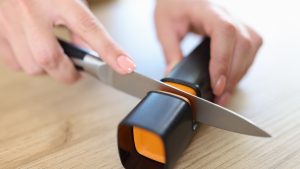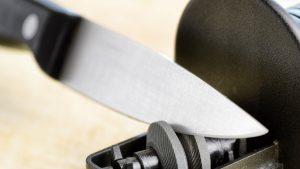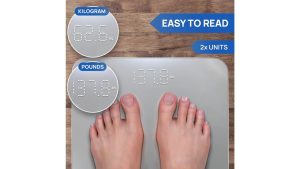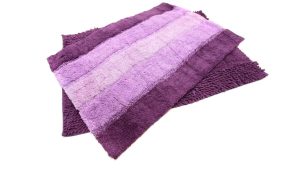If you’re an avid home cook or professional chef, you probably understand the importance of having sharp knives in your kitchen. Dull knives not only slow down your food preparation but also increase the risk of accidents. This is where knife sharpeners come into play. In this comprehensive guide, we’ll delve into the fascinating world of knife sharpeners, exploring how they work and the various types available.
Understanding the Basics of Knife Sharpeners
Knife sharpeners are essential tools designed to restore the sharpness and edge of a blade. They work by removing tiny bits of metal from the blade’s edge, creating a new, finely honed edge. Here’s a breakdown of the key elements of how knife sharpeners work:
1. Abrasives
Most knife sharpeners use abrasive materials, such as diamond stones, ceramic rods, or sharpening belts, to remove metal from the knife’s edge. These abrasives vary in coarseness, allowing you to choose the level of sharpness you desire. Coarser abrasives remove more metal, resulting in a sharper edge, while finer abrasives provide a polished finish.
2. Sharpening Angle
The sharpening angle is the angle at which the knife is held against the abrasive surface. Different knives require different sharpening angles, and it’s crucial to maintain the correct angle for optimal results. Knife sharpeners often come with built-in guides or slots that help users maintain the correct angle.
3. Pressure
Applying the right amount of pressure while sharpening is crucial. Too much pressure can lead to uneven sharpening and excessive metal removal, while too little pressure may not yield the desired sharpness. Quality knife sharpeners are designed to provide consistent pressure for efficient results.
4. Sharpening Stages
Many knife sharpeners offer multiple sharpening stages. These stages vary from coarse to fine, allowing you to start with a more aggressive sharpening and finish with fine honing. This approach ensures that your knife is not only sharp but also polished for precision cutting.
Types of Knife Sharpeners
Now that we’ve covered the fundamental principles of how knife sharpeners work, let’s explore the different types available in the market:
1. Manual Knife Sharpeners
Manual knife sharpeners are the most common and user-friendly option. They typically feature a handle and sharpening slots or rods. To use them, you pass the knife blade through the slots or along the rods at the desired angle, allowing the abrasive surface to sharpen the blade. Manual sharpeners are perfect for beginners and those looking for a quick and efficient sharpening method.
2. Electric Knife Sharpeners
Electric knife sharpeners are a more convenient option, as they do the work for you. These machines feature motor-driven abrasive wheels that automatically sharpen your knife when you insert it into the designated slot. They are a time-saving choice for busy kitchens and professional chefs.
3. Honing Rods
Honing rods, also known as sharpening steels, are long, cylindrical rods made of steel, ceramic, or diamond-coated materials. They are ideal for maintaining the edge of your knife between sharpening sessions. To use a honing rod, you simply run the knife blade along the rod to straighten the edge and remove any minor burrs.
4. Sharpening Stones
Sharpening stones, also called whetstones, are traditional and highly effective tools for knife sharpening. They come in various grit levels, from coarse to fine, and require some skill and practice to use correctly. By moving the knife across the stone in a controlled manner, you can achieve a razor-sharp edge.
Maintaining Your Knife Sharpener
To ensure your knife sharpener continues to work effectively, it’s important to maintain it properly. Here are some tips to keep in mind:
- Regularly clean the abrasive surfaces to prevent metal residue buildup.
- Check for any wear and tear on the sharpening elements and replace them as needed.
- Follow the manufacturer’s instructions for safe and efficient use.
Choosing the Right Knife Sharpener
Selecting the right knife sharpener depends on your specific needs and preferences. Here are some factors to consider:
1. Knife Type
Different knives have varying edge angles and blade materials. Ensure your chosen sharpener is compatible with the knives you use. For example, some sharpeners are designed specifically for serrated blades, while others work best with straight-edged knives.
2. Skill Level
Consider your experience and comfort level with sharpening. If you’re a novice, a manual or electric sharpener with built-in guides can be more user-friendly. However, if you’re skilled in knife sharpening, you may prefer the control and precision offered by sharpening stones or honing rods.
3. Frequency of Use
How often you use your knives influences your choice of sharpener. If you’re a professional chef or cook frequently, an electric sharpener might be more suitable due to its speed and convenience. For occasional home cooks, a manual sharpener or honing rod may suffice.
4. Budget
Knife sharpeners come in a wide price range. Invest in a sharpener that suits your budget and meets your sharpening requirements. Quality doesn’t always correlate with high cost, so research and read reviews to find the best value for your money.
Tips for Efficient Knife Sharpening
To achieve the best results when using your knife sharpener, keep the following tips in mind:
- Consistency: Maintain a consistent angle and pressure while sharpening. This will help create an even and sharp edge on your knife.
- Honing vs. Sharpening: Understand the difference between honing and sharpening. Honing is a quick maintenance step to straighten the blade while sharpening involves removing metal to restore a dull blade.
- Safety: Always exercise caution while sharpening knives. Use protective gloves and follow safety guidelines to prevent accidents and injuries.
- Regular Maintenance: Make sharpening a part of your routine to ensure your knives are always ready for use. A well-maintained knife is safer and more efficient.
- Test Your Edge: After sharpening, perform a simple paper or tomato test to check the sharpness of your knife. A properly sharpened knife should slice through effortlessly.
Wrapping Up
In the world of culinary arts, knife sharpeners are your best ally for maintaining the efficiency and safety of your knives. With the right sharpener and proper technique, you can achieve razor-sharp edges that make your kitchen tasks a breeze. Remember to choose the sharpener that suits your needs, maintain it regularly, and prioritize safety. Your kitchen will become a more enjoyable and efficient place with well-sharpened knives.
(FAQs) related to knife sharpeners:
1. What is the purpose of a knife sharpener?
- A knife sharpener is designed to restore and maintain the sharpness of knife blades by removing metal to create a keen cutting edge.
2. How often should I sharpen my knives?
- The frequency of sharpening depends on how often you use your knives. For regular home cooks, sharpening every few months is usually sufficient. Professional chefs may need to sharpen their knives more frequently.
3. Can I use a knife sharpener for serrated knives?
- Some knife sharpeners are specifically designed for serrated knives, but not all can accommodate them. Be sure to choose a sharpener that is suitable for serrated blades.
4. What’s the difference between manual and electric knife sharpeners?
- Manual sharpeners require manual effort and skill to use, making them more precise but slower. Electric sharpeners are more convenient and faster, but they may require less manual control.
5. Are there specific sharpeners for different types of knives?
- Yes, some sharpeners are designed for particular knife types, such as Asian or Western-style blades. It’s essential to choose the right sharpener for your knives for the best results.
6. How do I maintain a knife sharpener?
- Regularly clean the abrasive surfaces and replace them when they show signs of wear. Follow the manufacturer’s maintenance instructions for your specific sharpener.
7. Can I sharpen scissors with a knife sharpener?
- Some knife sharpeners have features for sharpening scissors, but not all of them do. Make sure to check the product’s specifications to see if it’s suitable for scissors.
Conclusion
In the world of culinary arts, a sharp knife is an indispensable tool. Understanding how knife sharpeners work and choosing the right one for your needs is essential for keeping your knives in top-notch condition. Whether you opt for a manual, electric, or traditional sharpening method, regular maintenance will ensure your knives stay razor-sharp and ready for any culinary challenge.







